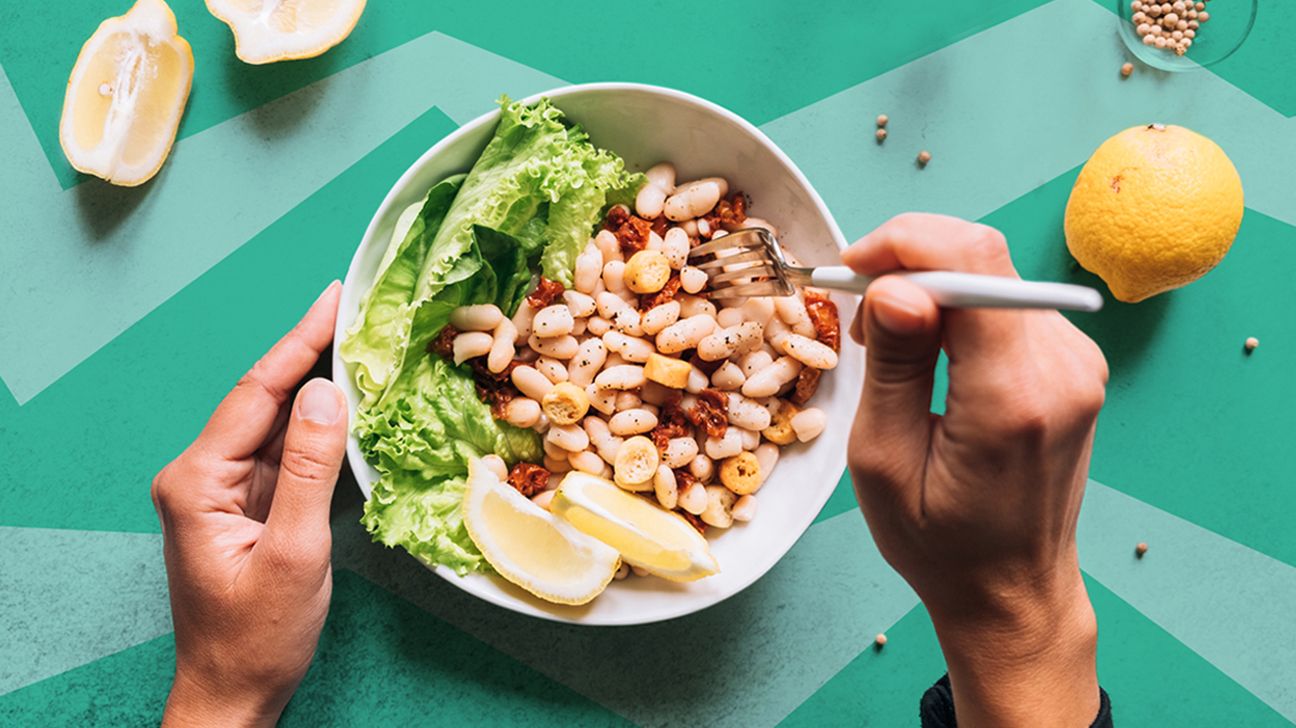Living with Crohn’s disease can make eating a literal pain. And if you have this chronic inflammatory bowel disease (IBD), there’s a ton of conflicting diet info that promises to help your symptoms.
So while some folks preach low carb and others swear by plant-based diets, those might not work for you.
What’s the best Crohn’s disease diet to follow?
The truth is, it depends on the person. The most important diet choice you can make with Crohn’s disease is to eat nutritious foods. This is because Crohn’s disease is often associated with malnutrition and nutrient deficiencies.
Let’s dive into what science has to say about the best Crohn’s disease diet tips and what foods to eat.

Every person with Crohn’s disease is different, so there’s no one-size-fits-all diet to treat Crohn’s. However, research shows making certain changes to your diet may help reduce symptoms, and even keep you in remission.
The top recommended dietary guidelines for folks with Crohn’s include
- limiting red and processed meat
- focusing on high fiber fruits and vegetables
- avoiding omega-6 rich fats like corn oil and safflower oil
- limiting or avoiding refined carbs and added sugars
- eating calcium-rich foods like yogurt
If you’re interested in a more structured diet, some studies suggest that plant-based diets or a Mediterranean diet might help improve symptoms, too.
Plant-based diets
Plant-based diets (including vegetarian and semi-vegetarian) are rich in fiber and believed to reduce intestinal inflammation and promote overall health in peeps with Crohn’s.
A 2010 study of 22 patients with Crohn’s disease found that 94 percent of those following a semi-vegetarian diet (lacto-ovo-vegetarian) maintained remission for 2 years. This was compared to just 33 percent of people who followed an omnivorous diet.
Case reports have also suggested some people with Crohn’s find success reaching remission by following plant-based diets.
Keep in mind: Folks with Crohn’s are already more likely to be deficient in nutrients that are usually low in plant-based diets like B12 and zinc. You may need to take supplements.
Mediterranean diet
A Mediterranean diet is rich in healthy fats like olive oil and fish, plus a good dose of fiber.
A 2019 study of 86 people with Crohn’s disease found a Mediterranean dietary pattern was associated with improved quality of life and reduced disease activity.
Another 2021 study, that included 142 people with IBD (58 with Crohn’s), found similar results.
People following a Mediterranean diet for 6 months had improved quality of life, improvement of disease activity, reduction of inflammatory markers, significant reduction in signs of malnutrition, and reduction of fat in the liver. Fatty liver or liver steatosis is more common in people with Crohn’s.
Other diets and treatments that may be helpful
Not about the plant or EVOO life? These diets and treatments may also help Crohn’s disease:
- Specific carbohydrate diet (SCD). The SCD diet removes sugars that are poorly absorbed in the GI tract, including grains, certain added sugars, and most milk products. Some studies suggest this diet can help reduce symptoms and lead to remission in people with IBD.
- CD Exclusion Diet (CDED). The CDED is a 12-week protocol that focuses on whole foods like fruits, vegetables, meats, and complex and simple carbohydrates. It cuts out certain fats, gluten, certain monosaccharides, and food additives. Studies show this protocol is an effective way to enter remission in folks with Crohn’s disease.
- Paleo Diet. The paleo diet excludes grains, dairy, refined sugars, and other ingredients that may be problematic for people with Crohn’s disease. Although research is lacking on going paleo for Crohn’s, anecdotal evidence suggests it may help improve symptoms.
- Exclusive Enteral Nutrition (EEN). EEN — exclusive feeding through a nutritionally complete liquid diet — is one of the most studied dietary interventions in people with active IBD. Research shows it’s quite effective for inducing remission in both kiddos and adults. Note: this is a short-term treatment.
- FODMAPs diet. The FODMAPs diet eliminates certain types of carbs that may cause digestive symptoms for 6 to 8 weeks. This is followed by a reintroduction phase. This diet may be helpful for reducing Crohn’s symptoms like diarrhea and bloating.
Call your doc and dietitian
Research on how diet affects Crohn’s disease is ongoing.
If you’re interested in treating your Crohn’s disease through diet, chat with a qualified healthcare provider like a doctor or registered dietitian. They can help you come up with the best plan for your specific needs.
Prepping meals ahead of time can help keep you eating healthy all day long. Plus, it can help take the guesswork (and the stress) out of figuring out what to eat.
Here are some helpful meal prep tips for folks with Crohn’s:
- If you’re experiencing a flare. Focus on meals with lean protein, low fiber carbs like white rice, and fully cooked, noncruciferous veggies like carrots.
- When you’re in remission. Try adding a source of fiber to every meal, especially fruits and veggies.
- Adding protein sources to every meal and snack can help keep you full. Think chicken, eggs, tofu, turkey, seafood, and pea protein.
- Keep your pantry and fridge stocked with your feel-good foods. Avoid purchasing foods or drinks that trigger your symptoms.
- Prep nourishing, balanced meals ahead of time. You can just store them in your fridge or freezer.
- Try to eat smaller, more frequent meals. Especially if larger meals tend to make your symptoms worse.
- Stay hydrated throughout the day. Sipping on water is really important if you’re experiencing diarrhea. Try a soothing cup of ginger or peppermint tea if you’re feeling nauseated.
During a flare, you’ll likely have symptoms like:
If you’re experiencing a Crohn’s flare, it’s typically recommended you avoid certain foods, and instead eat foods that may be better tolerated.
| Flare trigger foods | Potential flare-friendly foods |
| milk and dairy products | lean sources of protein like fish and chicken |
| whole grains | certain carbs like white rice and potatoes |
| raw vegetables | low fiber fruits like bananas and honeydew melon, as well as cooked fruits |
| fruits with skin and seeds | cooked veggies (avoiding cruciferous vegetables like cauliflower and broccoli) |
| whole nuts | certain protein shakes and liquid meal replacements |
| sugary foods and drinks like candy and juice | more low fiber or cooked fruits |
| alcohol and caffeinated beverages | water and other caffeine-free drinks |
| high fat foods like fried foods and oils | lean sources of protein |
| spicy foods | bland or only lightly seasoned foods |
If you’re experiencing a flare and don’t know what to eat, contact your doctor for advice.
If you’re in remission, eating nutrient-dense whole foods can reduce the risk of Crohn’s flares and help you feel your best.
Incorporating the following foods into your diet (and avoiding others) may help improve symptoms and reduce the risk of Crohn’s flare-ups:
| Foods to avoid or limit during remission | Remission-friendly foods |
| highly processed foods like fast food | fruits and veggies |
| foods with added sugar | fatty fish like salmon |
| red and processed meat products | protein-rich foods like chicken, turkey, eggs, and other seafood |
| fried foods | calcium-rich foods like yogurt and kefir |
| fiber-rich foods like beans and nuts | |
| fermented foods like kimchi and sauerkraut |
Some people with Crohn’s disease may not be able to tolerate the recommended foods on this list. If you find that certain foods cause symptoms like gas, diarrhea, or bloating, try cutting out those foods and work with a healthcare professional to identify other potential triggers.
Keeping a food journal can also help you pinpoint what foods bother you.
Get your supplements ready
In addition to eating a healthy diet, it may be necessary for people with Crohn’s disease to supplement with certain nutrients. Just chat with your doc before trying a new supplement.
People with Crohn’s are more likely to be deficient in several nutrients, including:
In general, folks with Crohn’s shouldn’t need to eliminate many foods from their diet to control their symptoms and stay in remission. However, others may find success after removing certain foods from their diet.
Many people with Crohn’s are intolerant to gluten and certain types of carbs. So, removing or restricting these foods could help you feel better if they bother you.
This is why self-experimentation and keeping track of how certain foods make you feel is super important. Working with your doc and a knowledgeable dietitian can also help you narrow down intolerances or food sensitivities.
Even though some high fiber foods may cause symptoms in peeps with Crohn’s disease, a low fiber diet isn’t recommended.
Unless you’re experiencing a flare or a doctor has advised you to follow a low fiber diet, continue to eat high fiber foods. Reasons your doc might recommend a low fiber diet include obstructive symptoms, strictures, or after a surgery like a colectomy.
Incorporating fiber-rich foods like veggies and fruits into your diet can actually help keep you healthy and reduce the chance of flares.
If you recently cut out high fiber foods due to a flare, make sure to reintroduce high fiber foods slowly (and one at a time) to reduce the chances of GI upset.
If you have Crohn’s disease, following a nutrient-dense diet can help keep you healthy and reduce the chance of flares.
If you need help finding the best diet to manage your Crohn’s symptoms, try working with a healthcare professional to come up with a plan.

